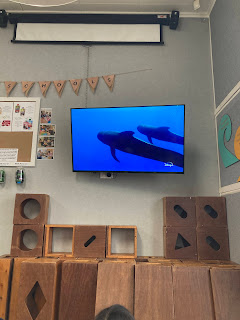After sharing kai we moved outside, where Ari told us
more about the taonga they had brought. Waiting in their vehicle, were some very special bones of
whales who had once swum in our harbour. Two bones from a Parāoa, or sperm whale, and a complete
skeleton of a pilot whale, or Upokohue, who was named Rangimaria.
In November 2006, Rangimaria had become stranded on the
beach outside the refinery at Marsden Point, along with many of her pod. Some of them were re-introduced
back into the ocean but a number of them stranded themselves again at Uretiti Beach. Many
people came from DOC, the local community and surrounding Hapu; first to try
and return Rangimaria and her whānau to their ocean home, and then later to
share stories, knowledge and customs around the right thing to do with the
remains of those magical creatures who could not be saved. The valuable
resources she provided were removed e.g. the blubber, from which precious oil
is obtained. Then she was buried in the sand, just under a metre deep, for a
whole year. This gave the bugs time to clean her bones naturally. After this
they were brought out of the sand. This skeleton was then named, and gifted by her guardians in Te Kao to the Patuharakeke te
Iwi Trust, for the purposes of educating people about the amazing Upokohue.
First we were shown the Parāoa vertebra and tooth - and they were so big!
When you compared the vertebra of the Parāoa with one from the Upokohue, you could imagine just how huge a Parāoa is! We learnt about the connection of these whales to our Mairtown Kindergarten pepeha and the name of our harbour ‘Whangārei te terenga Parāoa’.


The next day at whānau time, we revisited our visit with the
pilot whale Rangimaria. Having gained an understanding of her size, how her
body was made up, and the events that happened around her death, I shared some information about
her life. When she was alive she used to live in a group of mostly female and
juvenile whales, and she used to dive really deep and catch squid and octopus
to eat. (Parāoa love eating squid too!). Upokohue are actually members of the
Dolphin family – the second largest dolphins, with the Orca being the biggest.
When Rangimaria’s babies were born, they were already 6 feet long! We watched a
short YouTube video of a man swimming with pilot whales, which showed us what
she looked like and how she swam, and how she used to roll into a vertical
position to sleep!
https://youtu.be/YT8yLzC-9MM?si=DaJheuV8Ob41HCQZ
I had found an article about the event in 2006 which
caused her death, and the people trying to save her, and we wondered if Rangimaria
was one of the Upokohue in the photo!
https://www.nbcnews.com/id/wbna15652544
We are so grateful to Ari, Alyssa and Hollie for
sharing the precious taonga of Rangimaria and the Parāoa they care for with our
kindergarten. Thanks to them, we have had the privilege of building our own
special connection with these awesome creatures. They are a special part of our
environment, history, and with our support, our future too.
Through exploration and discovery, tamariki develop their knowledge, language, care, and creativity. Hands-on experiences such as our tamariki enjoyed today, support a growing connection with and sense of belonging in their own environment and community. They inspire an emergent sense of tiaki for the wellbeing of the amazing creatures living alongside us in te taiao. In time, our tamariki will become the decision leaders and change makers, nurturing the physical and social environment of our places, our communities, and our world.”
Nga mihi mahana, Anne Bawden









.png)
No comments:
Post a Comment